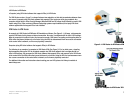
1
Chapter 1: Introduction
Welcome
10/100 8-Port VPN Router
Chapter 1: Introduction
Welcome
Thank you for choosing the 10/100 8-Port VPN Router. The Linksys 10/100 8-Port VPN Router is an advanced
Internet-sharing network solution for your small business needs. Like any router, it lets multiple computers in
your office share an Internet connection. But the unique dual Internet ports on the 10/100 8-Port VPN Router let
you connect a second Internet line as a backup to insure that you're never disconnected. Or, use both Internet
ports at the same time, and let the router balance your office's requirements between them for maximum
bandwidth efficiency.
The 10/100 8-Port VPN Router also features a built-in 8-port full-duplex 10/100 Ethernet switch to connect eight
PCs directly, or you can connect more hubs and switches to create as big a network as you need.
The Virtual Private Network (VPN) capability creates encrypted “tunnels” through the Internet, allowing up to 50
remote office or traveling users to securely connect into your office network from off-site. Users connecting
through a VPN tunnel are attached to your company's network — with secure access to files, e-mail, and your
intranet — just as if they were in the building. You can also use the VPN capability to allow users on your small
office network to securely connect out to a corporate network.
The 10/100 8-Port VPN Router can serve as a DHCP Server, and has a powerful SPI firewall to protect your PCs
against intruders and most known Internet attacks. It can be configured to filter internal users' access to the
Internet, and has IP address filtering so you can specify exactly who has access to your network. Configuration is
a snap with the web browser-based configuration utility.
As the heart of your small office network, the connection-redundant Linksys 10/100 8-Port VPN Router gives you
the connection reliability your business needs.
Ethernet: a network protocol that specifies how
data is placed on and retrieved from a common
transmission medium.
LAN (Local Area Network): the computers
and networking products that make up the
network in your home or office.
Bandwidth: the transmission capacity of
a given device or network
Browser: an application program that
provides a way to look at and interact with all
the information on the World Wide Web.
firewall: security measures that protect the
resources of a local network from intruders
Full-duplex: the ability of a networking device to
receive and transmit data simultaneously
IP: a protocol used to send data over a network
IP Address: the address used to identify a
computer or device on a network
network: a series of computers or devices
connected for the purpose of data sharing,
storage, and/or transmission between users


















